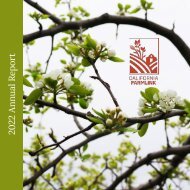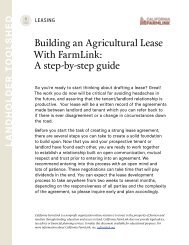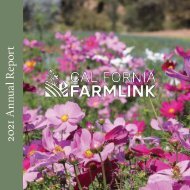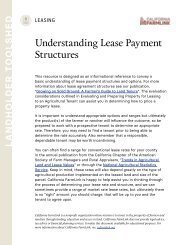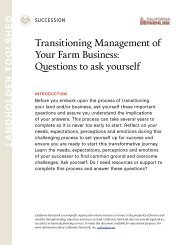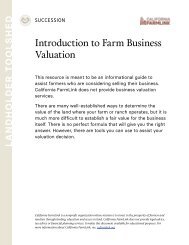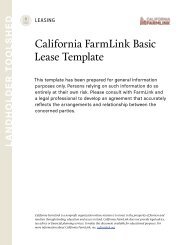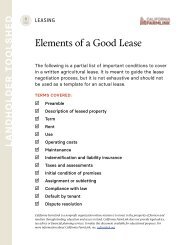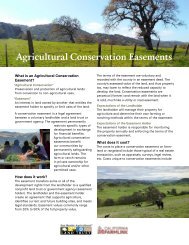Guide to Regenerative Grazing Leases: Opportunities for Resilience
California FarmLink and TomKat Ranch Educational Foundation teamed up to create this resource focused on land leases that support regenerative grazing practices. This guidebook aims to empower private, nonprofit, and public landholders, as well as easement-holders and grazing tenants.
California FarmLink and TomKat Ranch Educational Foundation teamed up to create this resource focused on land leases that support regenerative grazing practices. This guidebook aims to empower private, nonprofit, and public landholders, as well as easement-holders and grazing tenants.
Create successful ePaper yourself
Turn your PDF publications into a flip-book with our unique Google optimized e-Paper software.
CHAPTER 3. Agricultural Management Plans (Continued)<br />
MONITORING<br />
The type and intensity of moni<strong>to</strong>ring <strong>to</strong> be agreed upon should depend on the<br />
goals of the operation and the resources available. Even be<strong>for</strong>e working with a<br />
given lessee, it is important <strong>for</strong> landholders <strong>to</strong> collect baseline data and begin<br />
moni<strong>to</strong>ring ecological outcomes that are important <strong>to</strong> them. This not only helps with<br />
goal setting and planning, but also provides crucial baselines that can be used <strong>to</strong><br />
accurately measure the impact of a lessee's management. For long-term moni<strong>to</strong>ring,<br />
landholders and lessees should make sure their sampling and measurement methods<br />
are consistent (process, location, time of year, labora<strong>to</strong>ries used, etc.), and that the<br />
time and costs required <strong>to</strong> use these methods are realistic.<br />
Moni<strong>to</strong>ring can be as simple as visually assessing progress <strong>to</strong>wards a SMART goal,<br />
keeping good records in a field journal, and collecting pho<strong>to</strong> documentation. For<br />
example, it is possible <strong>to</strong> qualitatively determine whether a ranch’s management is<br />
providing habitat <strong>for</strong> wildlife by setting up game cameras in the field or by keeping a<br />
bird list. Visual assessments of the soil can also be made, including ones <strong>for</strong> smell,<br />
color, rooting patterns, and signs of life.<br />
In some cases, it may be desirable <strong>to</strong> conduct more rigorous or quantitative<br />
assessments. These can include af<strong>for</strong>dable, low-tech options like bare ground<br />
estimates using a quadrat or transect, soil compaction tests using a penetrometer,<br />
in-field assessments of soil aggregate stability, or water infiltration estimates using<br />
a homemade infiltrometer. They may also include methods or measurements that<br />
require some sort of technical assistance, such as point counts <strong>for</strong> bird diversity,<br />
soil sampling <strong>for</strong> labora<strong>to</strong>ry analysis of carbon and other parameters, or vegetation<br />
surveys using standardized methodologies.<br />
Carrying on the examples from above, one way <strong>to</strong> track progress <strong>to</strong>ward the first<br />
SMART goal would be by conducting bird point counts across multiple years<br />
(Please note: Goals that include migra<strong>to</strong>ry animals should also consider the overall<br />
populations in comparison. If there is a downward trend in overall populations due<br />
<strong>to</strong> off-property land management impacts these can have far greater consequences<br />
than what is accomplished on one ranch.) Progress <strong>to</strong>wards the second SMART<br />
goal could be tracked by sampling soil every few years and analyzing it at a service<br />
labora<strong>to</strong>ry <strong>for</strong> soil carbon using the dry combustion method. Progress <strong>to</strong>ward the<br />
third SMART goal could be tracked by measuring water infiltration rates using the<br />
single ring infiltrometer method and comparing rates <strong>to</strong> those from neighboring<br />
properties or published values from the surrounding region. Finally, progress <strong>to</strong>ward<br />
the fourth SMART goal could be tracked by conducting a yearly vegetation survey<br />
using the line-point intercept method and comparing counts of invasive species from<br />
be<strong>for</strong>e grazing started and after.<br />
© Copyright 2022 Cali<strong>for</strong>nia FarmLink and TomKat Ranch Educational Foundation<br />
40



